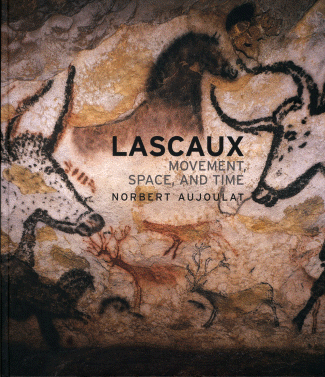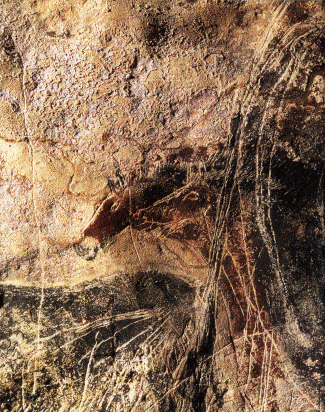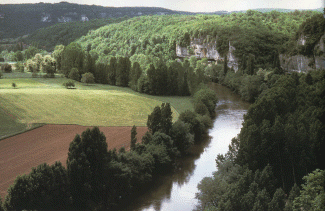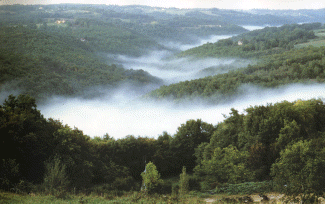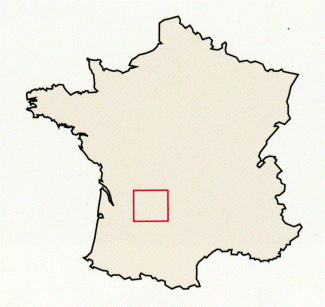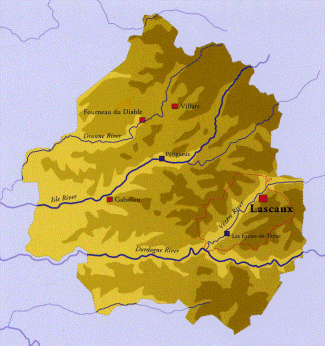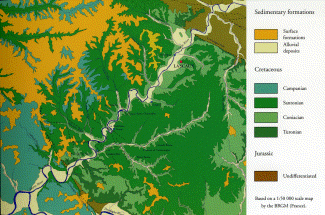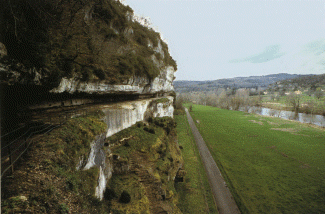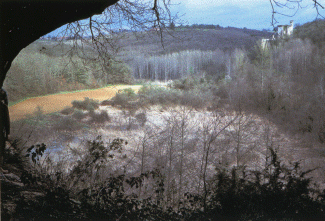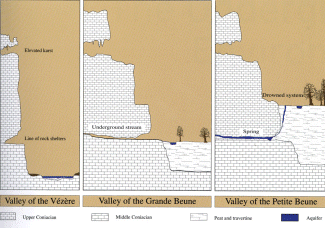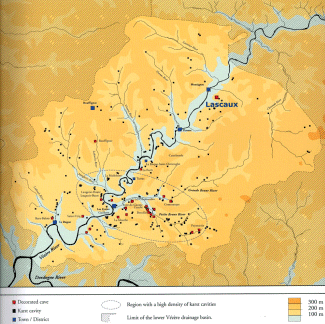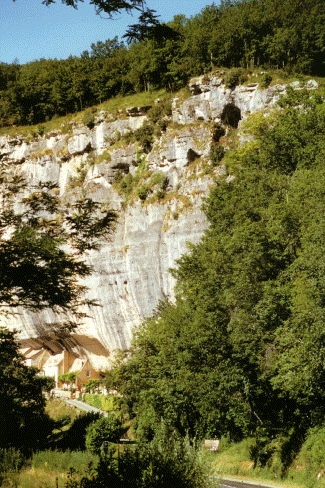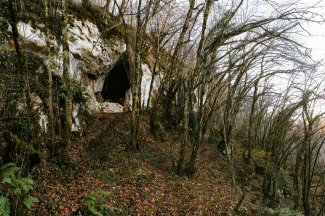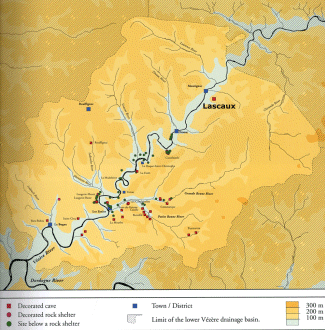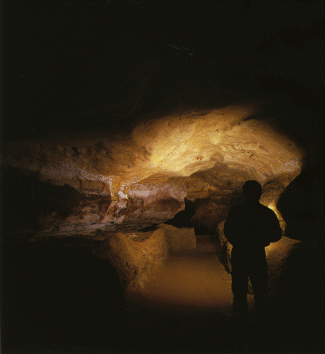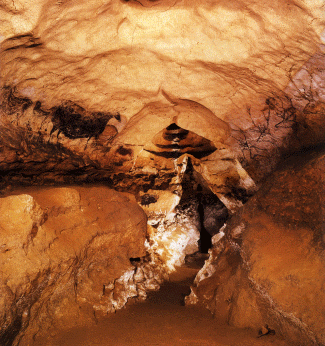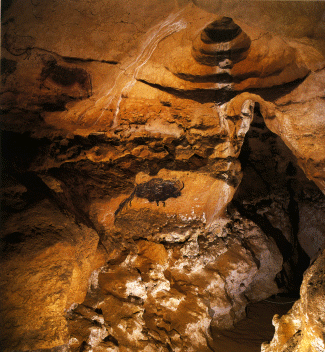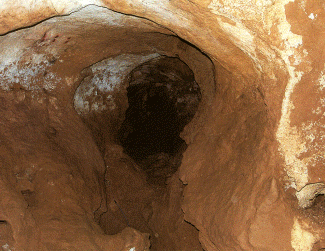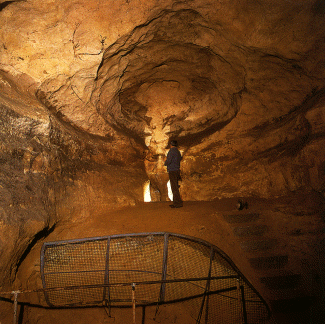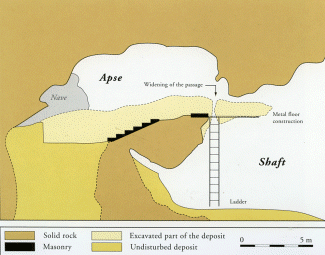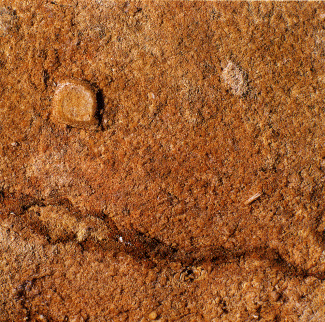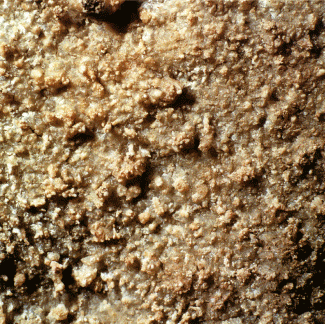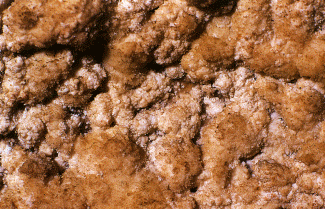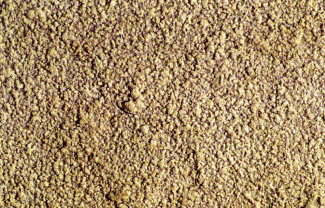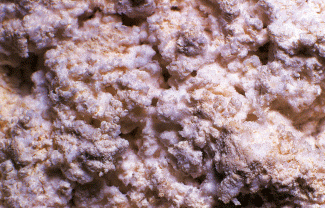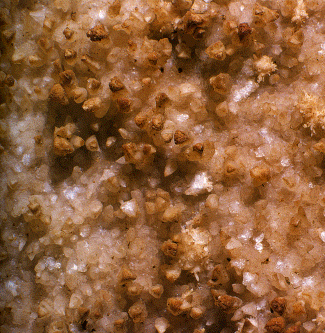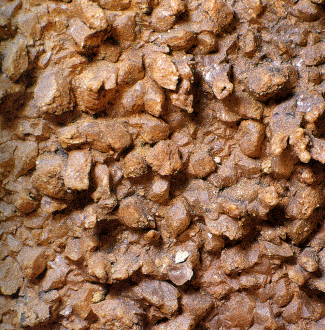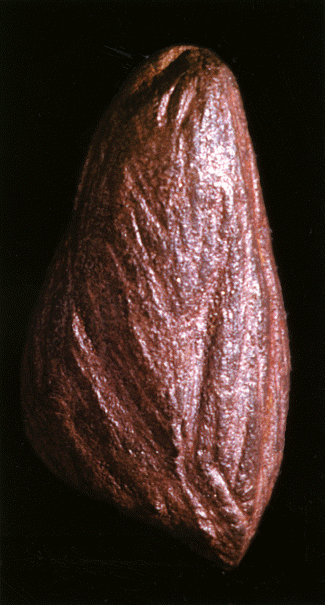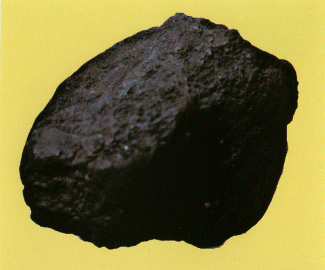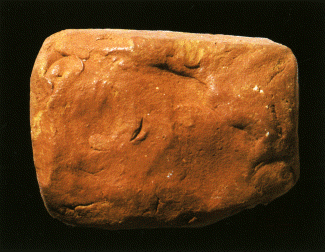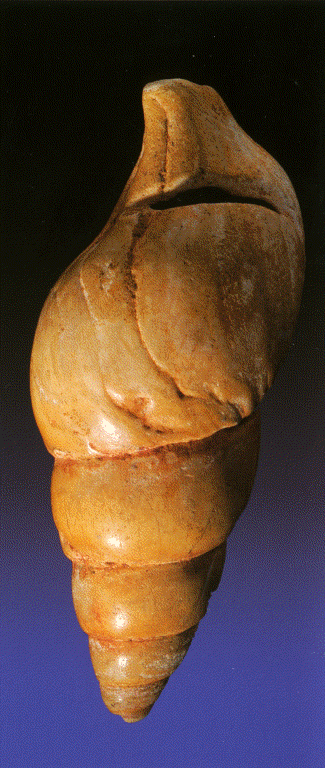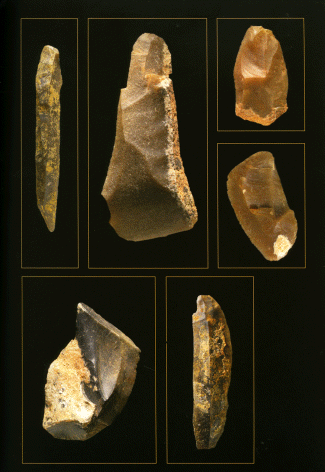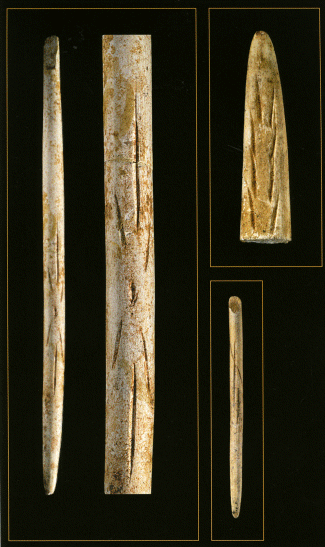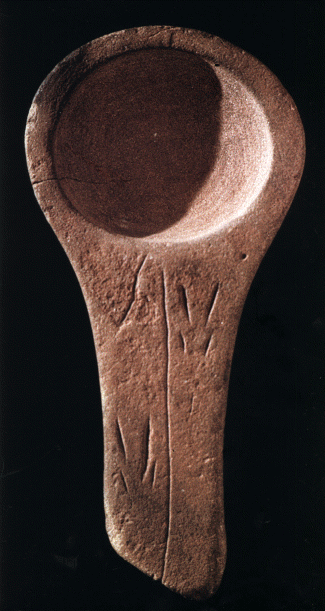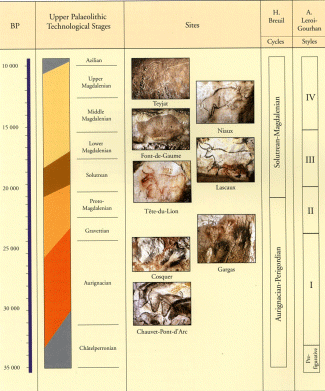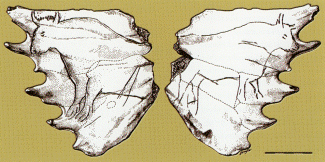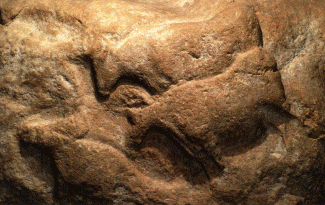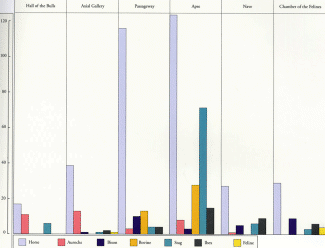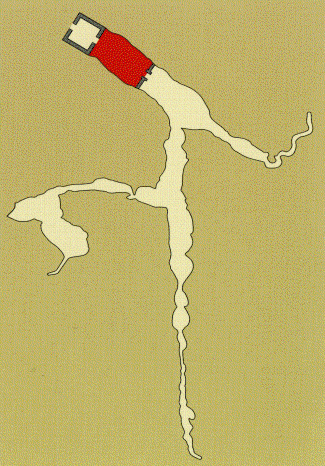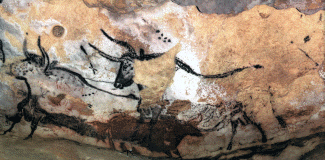Chapter 3: The Cave of Lascaux 13 The Lascaux hill. The formation projects into the valley.
13 The Lascaux hill. The formation projects into the valley.Lascaux Cave's geographical position places it some distance from the major concentrations of decorated caves and habitation sites that line the downstream stretch of the Vezere and its tributaries.
The present entrance to the cave, 185 metres above sea level, overlooks the valley floor by 105 metres. The road linking Montignac and Lascaux passes through the entire Coniacian sequence. The underground system is developed most completely in the uppermost part of this horizon. The first strata of the Santonian appear approximately 5 metres above the present entrance.
The cave is integrated into a hilltop formation, the summit of which is today masked by important slope deposits. These deposits smooth the outline of the hill, a phenomenon resulting from distortion of the Santonian basement rock (ill. 13). It is one of the characteristic features of the landscape.
Access to the SiteA relevant question is how humans gained access to the cave in the Upper Palaeolithic. As with the other caves in this region, once you get past the first 30 metres, the underground passage has changed very little since that time. Only the sectors close to daylight have been subjected to natural changes, although these have sometimes been considerable.
Several clues allow us to sketch out an initial answer, particularly with regards to possible entrances to the system. Indeed, a group of geological, morphological, palaeontological and conservational arguments allows us to support the hypothesis of a second entrance to the cave of Lascaux at the end of the Great Fissure.
The level corresponding to the ceiling of the cave is characterized by poorly indurated and highly fractured rock, which makes the formation of a rock face impossible. The entrances used by Palaeolithic man never opened widely on to the valley, in fact quite the opposite. At that time, the immediate landscape was restricted to a barely visible ridge shared by both possible entrances. The similar contours oft he openings and their location at the same level suggest that they were filled in at the same moment in time. This could have been caused by the collapse of part of the ceiling of the porch, erosion of their frontages, the influx of mudflows or the effects of solifluction phenomena (the transport of surface sediments resulting from the alternate freezing and thawing of soils). If you compare Lascaux with other caves belonging to the same geological level, you notice the same superficial character of the system, suggesting multiple entrances.
At the end of the Great Fissure, where the second entrance would have been located, the morphology of the chamber confirms that it is identical to that of the present entrance to the site. Its collapsed ceiling is very close to the outside surface and touches the top of a scree deposit that partly fills the gallery. An absolutely identical formation also blocked the present entrance before it was removed to make room for the engine room. At the wall of the Shaft Scene, other elements support this suggestion, notably the initial narrowness of the passageway connecting the Apse to the Shaft and the broadened cross section of the underlying gallery (ill. 14). This combination of factors accentuates the difficulty of passing from one space to the next and makes a return to the upper level almost impossible without proper equipment, something that was recognized at the time of Lascaux's discovery.
During the course of excavations conducted by Andre Glory, numerous remains of bones were unearthed. Almost 95 per cent of the remains came from cervids (reindeer and red deer), but wild boar and horses were also present. The remains also included microfauna. Apart from bats, several other species were identified: edible dormouse, garden dormouse, hare, water vole, hedgehog and frog. With the exception of the blue hate, all species show differing degrees of affinity with the entrance passages to the subterranean world. J. Bouchud, [7] who analysed the fauna at the site, questioned how these remains of micro-mammals arrived in the cave, attributing their presence to either predators or water. He ruled out the latter, since the Shaft bas not been affected by water with the exception of some percolation that bas deposited a fine calcite encrustation over the archaeological levels. A potential predator was a possibility, but this is pure speculation as no bone remains of carnivores have ever been recovered.
Predator or not, an external access to this branch of the system must have existed. Neither the edible nor the garden dormouse penetrates more than a few tens of metres into the interior of caves. The other species in particular the frog and the hedgehog were unable to gain access to the upper level, which indicates that these animals were restricted to the Shaft, the Great Fissure and the Silted-up Chamber. This presupposes an opening to the outside world very close to the place of their burial.
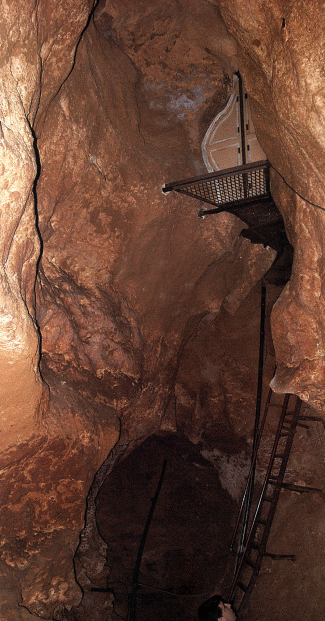 14 The Shaft. A difference in altitude of 6 metres separates the Apse from the bottom of the Shaft. The Scene, hidden by a projection of the cave wall, unrolls on the wall facing the descent by ladder.
14 The Shaft. A difference in altitude of 6 metres separates the Apse from the bottom of the Shaft. The Scene, hidden by a projection of the cave wall, unrolls on the wall facing the descent by ladder.One feature of this type of underground architecture with several openings is that the limestone deteriorates by dissolution. a phenomenon related to the exchange of air between the outside and the cave. This observation and the traces of corrosion on the walls thus give us another clue. We have mentioned the chemical processes linking condensation of water to carbon dioxide, as well as their effects on the limestone support. At Lascaux:, this phenomenon is accentuated by the presence of an important updraft of carbon dioxide at the base of the Shaft, [8] and measurements taken daily show that this can reach a concentration of 6 per cent.
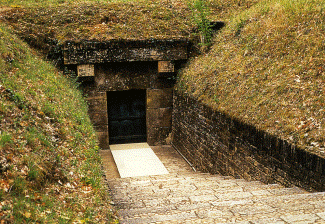 15 A ramp provides access to Lascaux, which is sealed from the outside world by a monumental door.
15 A ramp provides access to Lascaux, which is sealed from the outside world by a monumental door.The zones affected by this form of deterioration are not distributed randomly bur are governed by two factors that determine the different actions of the corrosion: the geometry of the galleries and the direction of atmospheric circulation. This affects the condition of the walls and indicates the main directions of air flow.
A detailed analysis of those sectors affected at Lascaux has highlighted a particular axis of circulation, which has made the deterioration in the Apse and the Passageway more pronounced than in the Nave or the Chamber of the Felines. The majority of the pigment applied to the walls or the ceiling has disappeared as a result of this decay. The most damaged area is near the opening to the Shaft, bur the upper part of the Apse has also been affected: of the two great horses, which decorated the entire ceiling, only a few engraved lines remain, while the colouring matter survives only as a ghostly image. The Passageway bears the same scars, and only the painted figures in the lateral niches (particularly over the first 3 metres) are intact. On the fan-shaped surface on the right wall of the Hall of the Bulls, at the entrance to the Passageway, the hindquarters of the fourth bull and the great aurochs's head have also deteriorated. This series of observations proves the existence of a major flow of air, which made its destructive effects felt throughout all the sections of the gallery between the present-day entrance zone and the top of the scree deposit of the Great Fissure. It would therefore seem that there were indeed two distinct entrances to the Lascaux system: the one that is in use today (ill. 15), and the other, at the end of the Great Fissure, which was filled in by slope deposits and thereby concealed following the passage of Palaeolithic man. [9]
Architecture of the CaveLascaux has traditionally been divided into seven sectors (ill. 16) according to topography: the Hall of the Bulls (also known as the Rotunda), the Axial Gallery, the Passageway, the Nave, the Chamber of the Felines, the Apse and the Shaft. The undecorated portions are also included in this book, however. namely the entrance zone. the terminal passage, the Mondmilch Gallery (between the Nave and the Chamber of the Felines), the Great Fissure and the Silted-up Chamber (located beyond the Shaft).
Excluding the terminal passage, the final extension of the Axial Gallery and the umbilicus of the Silted-up Chamber, the system of galleries accessible to man -- in all around 235 metres long -- can be split into three distinct rectilinear segments of unequal length. They are divided along three major axes: the first, at an angle of 1200 relative to north, comprises the entrance zone, the Hall of the Bulls and the Axial Gallery; the second, orientated north-south, includes the Passageway, the Nave, the Mondmilch Gallery and the Chamber of the Felines; and the third segment, consisting of the Shaft and the Great Fissure, is at right angles to the second, with an east-west orientation. Beyond this, in a chamber following an identical orientation to the first segment, an important scree deposit marks the intersection between the extremity of the Great Fissure and the opening of the Silted-Up Chamber on the left.
The longitudinal sections reveal the different levels of the cave, which gets progressively deeper from the present- ay entrance to the Chamber of the Felines. It drops 13 metres from the entrance to the Axial Gallery, a further 19 metres to the base of the Shaft and then another 20 metres to the bottom of the south shaft in the Chamber of the Felines.
THE ENTRANCE ZONEThe space between the present entrance and the Hall of the Bulls, some 20 metres long, is divided into four sections or airlocks. These partitions are designed to protect the decorated zones from external, potentially harmful climatic influences.
When the cave was first discovered, a great cone of scree filled the entrance zone. In 1948, however, it was levelled off to make the path wider, and access to the cave was facilitated by the introduction of a stairway. The installation of an air-conditioning system a few years later necessitated the removal of part of the sedimentary formation.
Differences in ground level and the changing nature of the porch, the facade of which has been cut back several metres since the Palaeolithic, have altered the appearance of the entrance over time. This is linked to the last incidence of subsidence in the roof, which buried archaeological layers dating to the same period as the parietal works of art. The ground surface formed by the scree cone followed a slight slope of around 20°, and the foot of the talus deposit was 5 metres further back than at the time of the discovery (ill. 17).
From the entrance, the extremely fragmented upper layer acts as a drainage system. Water is filtered through the 1. 5metre- thick rock stratum until it reaches the base, where it is prevented from going any further by a marly layer some 30 centimetres thick (located above the ceiling of the fourth airlock and beyond). The water diverted in this way percolates through the facade, which is chamfered by erosion. It used to flow across the scree talus towards the Hall of the Bulls, but now it is collected and pumped out of the cave.
During the Upper Palaeolithic, the less pronounced slope led towards an oblong hall. Today, this is cut off by the partition that separates the Hall of the Bulls from the rest of the cave system. The cross section of the entrance area prefigures that of the Hall of the Bulls. Shaped like a diabolo, it is divided into two levels of approximately equal height, separated by a ridge.
THE HALL OF THE BULLSThe Hall of the Bulls is a natural progression from the airlocks and retains the same characteristics (ill. 18). It is 19 metres long and varies in breadth from 5.5 metres at the entrance to 7.5 metres at its widest point, next to the opening to the Passageway.
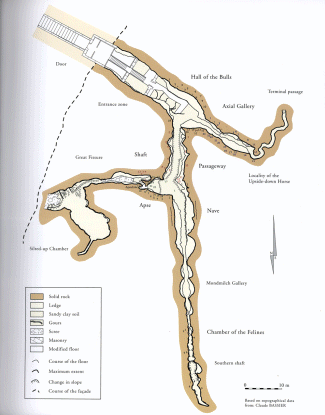 16 Planimetric record of Lascaux and location of the principal figures and panels.THE HALL OF THE BULLS
16 Planimetric record of Lascaux and location of the principal figures and panels.THE HALL OF THE BULLS1. Black horse's head
2. Unicorn
3. Frieze of the black horses
4. Head of the first bull
5. Great red and black horse
6. Second bull
7. Brown horse
8. Frieze of the Small Stags
9. Third bull
10. Red cow
11. Fourth bull
12. Black horse in the forequarters
of the fourth bull
13. Small black stag
14. Polychrome headless horse
15. Bear
16. Fifth bull
17. Red cow followed by her calf
18. Head of a bull
THE AXIAL GALLERY1. The Red Cow with the Black Collar
2. Frieze of the yellow small horses
3. The Cow with the Drooping Horn
4. Red cow painted on the ceiling
5. Great Black Bull
6. Frieze of the heads of yellow cattle
7. Red cows covered
by the Great Black Bull
8. Panel of the Hemione
9. Galloping Horse
10. Feline
11. Yellow horse and polychrome horse
12. Upside-down Horse
13. Red Panel
14. Confronted Ibexes
15. Superposed horses
16. Large red quadrangular symbol
17. Falling Cow
18. Solitary head of a bull
19. Frieze of the Small Horses
THE PASSAGEWAY1. Traces of a painted equid
2. Hindquarters and beginning of the
belly line of a painted equid
3. Head of a bison
4. Procession of engraved horses
5. Horse rolling on the ground
6. Engraved ibex and painted hooves
of an equid
7. Engraved and black painted horse
8. Horse with the turned-back foot
9. Heads and horns of cows
10. Red drawing of a headless equid
11. Engraved ibexes and horses
12. Two horses engraved one above
the other
13. Bearded Horse
THE APSE1. Stag with Thirteen Arrows
2. Fallen Stag
3. Third great stag
4. Horse and aurochs
5. Confronted stags
6. Confronted ibexes
7. Upward-turned Horse
8. Panel of the Musk Ox
9. Horse with Claviforms
10. Frieze of the painted and engraved stags
11. 'Chimney' sign
12. Small Sorcerer
13. Great Reindeer
14. The two bison
15 'fend-la-bise' Stag
16. Major Stag
17. Great stag and horse with merged
outlines
18. The Hut
19. Engraved stag on black background
20. Great Sorcerer
21. Red horse
22. Yellow horse
THE SHAFT SCENE1. Rhinoceros
2. Six black dots
3. Man
4. Bison
5. Bird
6. Black horse
THE NAVE1. Panel of the Ibexes
2. Panel of the Imprint
3. Panel of the Great Black Cow
4. Crossed Bison
5. Frieze of the Swimming Stags
THE CHAMBER OF THE FELINE1. Niche of the felines
2. Horse in frontal view
3. Quadrangular signs
4. Crossed bison
5. Panel of the horse
6. Tree house
7. Sign XIII
8. Head and horns of a bison
9. Six red dots
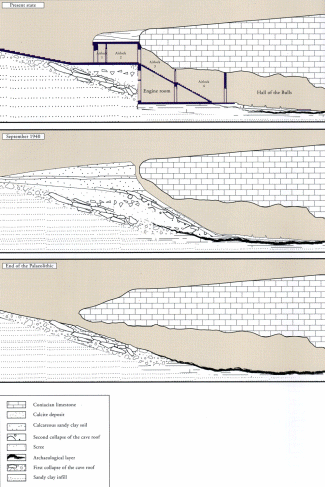 17 Longitudinal stratigraphic section from the entrance to the Hall of the Bulls at different periods: during the Upper Palaeolithic, the 12 September 1940 and in its present state.
17 Longitudinal stratigraphic section from the entrance to the Hall of the Bulls at different periods: during the Upper Palaeolithic, the 12 September 1940 and in its present state.The walls are made up of three superimposed levels. The upper, concave level features a single line of three cupolas of decreasing diameter, followed by a short row of smaller connecting cupolas, extending over 4 metres at the far end (before the entrance to the Axial Gallery). It is separated from the level below by a pronounced horizontal ridge. The central level, which runs along both walls, evolves from an inconspicuous sub-vertical formation at the entrance into an overhanging mass (with a maximum inclination of 70º) at the fur end of the hall. Moreover, its breadth quadruples from 1 to 4 metres. The combined effect of these two layers and the omnipresence of the painted images are significant, making you feel surrounded on all sides, and in this sense the alternative name given to the hall -- the Rotunda -- is very apt. The third level, which compensates for the increased difference in altitude, is quite modest at the entrance to the hall, but accounts for a third of the wall's height at its centre. We call it the bench.
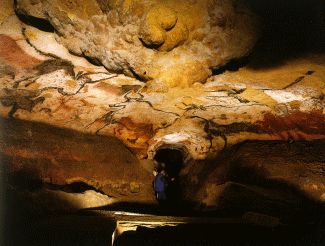 18 In the Hall of the Bulls, the decorated surface occupies the central part of the raised wall, which is distinctly corbelled.
18 In the Hall of the Bulls, the decorated surface occupies the central part of the raised wall, which is distinctly corbelled.Since the departure of Palaeolithic man, only the floors have been modified. In the majority of places, Andre Glory's test trenches reveal much the same sequence. At the base there is a deposit of alternating layers of fine sand and laminated clay, ranging in thickness from 2 metres in the Passageway to 4 metres in the Shaft and sealed by a compact, sandy band of clay of between 3 and 10 centimetres. Most of the portable archaeological finds were collected at its surface. A later but similar deposit of sediment only partially covered the Palaeolithic floor. During the Postglacial period, a very significant calcite deposit was formed along the subterranean watercourse. Four major petrified gours, with an average diameter of 4 metres, lie along the central axis of the Hall of the Bulls. The outflow towards the Passageway caused similar sedimentation beyond the hall, right up to the threshold of the Chamber of the Felines. However, the concretion (the hard, solid mass formed by the accumulation of calcite) of the floors allowed the deposition of clay layers along the left side of the gallery up to the foot of the wall.
The calcite cover is 20 centimetres thick on average, although some of the calcite natural dams are as much as 40 centimetres high. The physical traces of prehistoric man are buried below this layer in the clay sediments. The original floor of the gallery lies on average 30 centimetres below its current level.
THE AXIAL GALLERYThe Axial Gallery (ill. 19) is over 22 metres long and follows an almost identical orientation to that of the Hall of the Bulls. The floor has a gradient of 10 per cent, which becomes slightly more pronounced at the far end, beyond the Chinese Horses. For the purposes of this book, the passage has been divided into three sections of roughly equal length. The limits of these sections have been determined by two constrictions in the walls of the gallery, where the passage narrows to less than 60 centimetres wide. With visitors in mind, the first constriction was widened by removing a pronounced formation at the foot of the right wall.
A cross section of the passage shows that the Axial Gallery is shaped like a keyhole. Like the Hall of the Bulls, it has remained unchanged since the Upper Palaeolithic, with the exception of the floor Unfortunately, the floor has been disturbed several times since the cave's discovery and there is very little information about its original state. Trenches were dug for electric cables and ventilation ducts from the entrance right up to the terminal passage, disturbing the stratigraphy of the floor along the entire length of the gallery.
The stratigraphic sequence is identical to that in the other sectors of the cave. The archaeological layer, above the sterile fill of alternating bands of laminated clay and pal, grey sand, contained a relatively large number of portable items - in particular cores, flint bladelets and knapping waste, with traces of wood charcoal and fragments of colouring materials. This layer was sealed by 10 centimetres of compact clay and a thil calcite encrustation, formed by a flow of water trickling down the entrance. Compared to the palaeosol of the Hall of the Bulls, there is a difference in height of 3 metres. However, preliminary observation made by Henri Breuil [10] shortly after the discovery and recorded by Jacques Marsal showed that the floor at the entrance to the gallery formed a ridge that was almost 1 metre higher than its current level -- subsequently worn down by the huge number of visitors passing through. Local drainage of the fill or the collapse of animal burrows may have played their part. Indeed, at the entrance to the Passageway, at the base of the left wall, there were badger claw marks.
The third segment of the Axial Gallery has a relatively complex structure and confined space compared with the linearity and impressive size of the cave system thus far. A major constriction at the base of the passage marks the location of the Upside-down Horse (ill. 20), from which point the passage takes a meandering course, turning through 300º. The ceiling height drops significantly over this 7-metre section, from 3.2 metres at the entrance to 1.2 metres at the far end of the gallery.
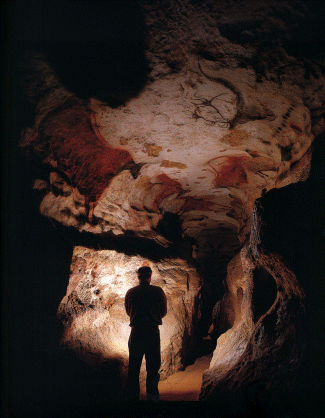 19 The entrance to the Axial Gallery illustrates perfectly the morphology of the passageway, showing its 'keyhole-shaped' cross section in particular
19 The entrance to the Axial Gallery illustrates perfectly the morphology of the passageway, showing its 'keyhole-shaped' cross section in particularA cross section of the gallery highlights the clear gap at the base of the wall where the lower level has crumbled away, creating a projection in the rock around which the image of the Upside-down Horse unfurls. Immediately before this formation the same break in the strata forms a series of small adjacent cavities, a few centimetres in size. On the opposite wall there is a deep fissure some 20 centimetres wide, which runs the length of the Red Panel, the final composition in this passage.
Beyond these last representations, there is a narrow sub-horizontal passage. It is some 15 metres long, but then becomes blocked by a sandy-clay obstruction.
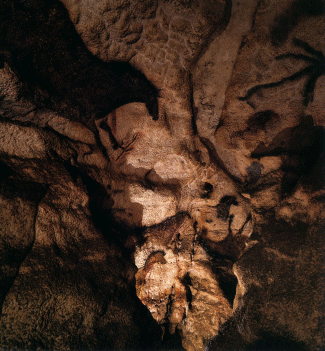 20 The second narrowing of the Axial Gallery marks the entrance to the location of the Upside-down Horse.
20 The second narrowing of the Axial Gallery marks the entrance to the location of the Upside-down Horse.
